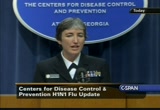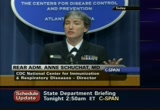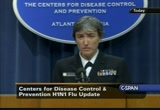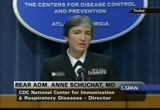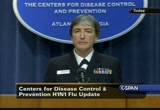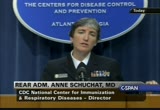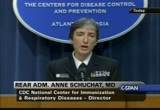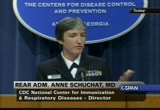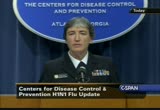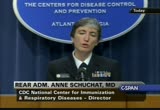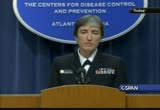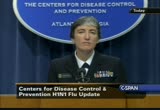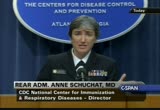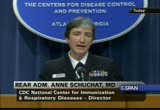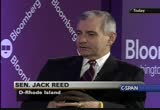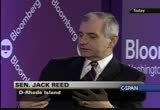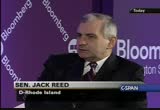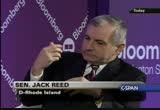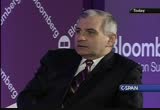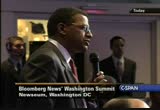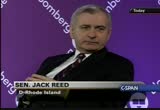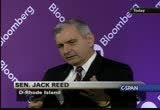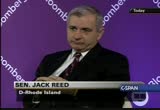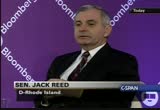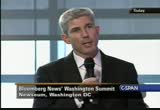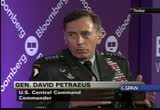tv Nancy Grace HLN November 13, 2009 1:00am-2:00am EST
1:00 am
family. these estimates give a bigger picture of what is going on and they really reaffirm the priority recommendations that were given. we focus vaccination on younger people because they are disproportionately affected with the virus. things have not really changed from last week to this week. we just feel we are finally able to update the public on how big a toll this virus is having so far. this is just the first six months, and i am expecting all these numbers to continue to rise. >> there is some resistance among some doctors out there to the vaccine. do you have any idea how much resistance, or do you have a sense of how many doctors are reluctant to recommend a vaccine? >> we have been carrying on a number of different monitoring efforts, including some surveys of providers. initially we were interested in
1:01 am
whether providers were going to sign up to give out the h1n1 vaccine. i have to say we have a very get an update of providers that do want to be able to offer it. we did not have as many providers -- we have been encouraging obstetrician- gynecologists to offer up vaccines in general because they reach such an important population. . . bout individual providers there really are skeptical and i just think it is critical for the consumer and the public to get good information. usually the health care provider is a good source. what i would say is that influence is really serious and i think the vaccine we have is the best way to protect patients -- what i would say is that influenza is really serious. influenza is really serious. >> of doctors, 10% of doctors? any sense of the numbers? >> i do not know, sorry.
1:02 am
a question on the phone line? >> this is stephen smith with the boston globe. i have two questions, the first regarding the pediatric deaths. this figure, this estimate of 540, that is several multiples higher than what had been given in the previous season of influenza. i am wondering at this point, are you able to say definitively that this pathogen is producing a more serious illness it more children than the seasonal strength that we have seen in 2004, when the tracking began in more earnest? secondly, and a related question, i am wondering what you are hearing about stockpiling in the business
1:03 am
community and what your concerns are about inappropriateness of that? >> thank you for both of those questions. that is important to compare apples to apples. the pediatric death reporting that was initiated in 2004 focuses on children who have had a laboratory-confirmed influenza infection, and looking at the same system, the pediatric- reporting, not the estimation method, i have already seen a larger number of deaths and we have in several years. i do believe that the pediatric death toll for this pandemic will be extensive and much greater than we have seen with the seasonal flu, but it would be better to compare the 129 number with the previous years of around 40, 88 deaths or so than to look at that 540 number. there are many ways that we talk about the poll that the seasonal flu has on the population. those are often derived from models or retrospective reviews
1:04 am
of data. when we talk about 36,000 deaths, 96% in seniors, those figures are more comparable to what we're talking about here with the estimation, although those are derived from a different approach from what we are describing. if you think about that, that only about 10% of the seasonal flu deaths occur in people under 65, that would be about 3600 deaths. we think that we are having a fairly severe amount of deaths so far from this h1n1 virus, and of course we are only -- the numbers i have given our only through the first six months, the middle of october, and we have had a lot of disease since then and we will have a lot of disease going forward, hopefully much of it mitigated by the vaccination effort. the second question was about stockpiles in the business community. i want to mention for several years there has been a lot of pandemic prepared this effort going forward.
1:05 am
the states, cities, the business community, public and private sector, really look into their own and try to figure out how to be ready when something happens. from my knowledge, i believe a number of companies actually looked at what to expect and thought maybe we better get ahead of this and prepare some anti-viral stockpiles for our workers as the public private partnership responsibility. i do not have the updated information about how many businesses have done that, but i believe the practice started several years ago with all the preparation around the h5n1 bird flew situation. another question on the phone? >> hi, doctor. there is an echo on this line and it is a little bit hard to hear. i wanted to ask you about how states are deciding who to vaccinate, against the backdrop of this assignation shortage.
1:06 am
which of the priority groups is the highest priority, given the estimates? >> thank you. the question is about a priority groups and whether there are some priorities. the committee met in july and came up with the target population that accounted for about half of the u.s. population. then they also went through a sub prioritization effort or the camera put a smaller group of people. when we surveyed the states in large cities about how they're addressing the target population, some of them are focusing on the sub priority group. there was about 42 million total population targeted, and it involved children 6 months of age through five years, and then 5-year-old threw a 18-year-old with chronic conditions. it did not involve people 18 to 65 with chronic conditions,
1:07 am
including health-care workers and pregnant women and parents of caretakers and young babies. basically, by looking at the healthy school-age children it took a small population. one of the problems with that effort is that not all vaccine formulations can be given to everyone. about a quarter of the vaccine supply we have right now is live attenuated vaccine, the nasal spray, and that can only be given to people who are held between the ages of 2-49. some of the states and cities found a focus too much on that sub prior to group the cannot really ought to milieus the formulation. -- they could not really focus on the formulation. what we had heard from the states and the community is in his support for them have flexibility. we know from surveying the city and county health departments that the vast majority are reaching out to party
1:08 am
populations through providers who serve them, hospitals, mass clinics targeting young people and pregnant women, and through some special the clinics. there is a mixture of activity out there which is probably good. averil area and the city really cannot be served by exactly the same method -- a rural area and the city really cannot be served by the exact same method. there are a variety of efforts. another thing to say is that going forward, as we get more and more vaccine each day, the risk of focusing too narrowly is that you are not able to address all the doses that you get. we know in the first couple of weeks that many states were turning people away online because there was not enough vaccine at the clinics for all of them to be covered and focused on just the people in
1:09 am
line who are from the priority groups. another question from the room? >> below, i am from french tv. in france, only about 20% of the population is going to get vaccinated. what you think of that, first. also, they say that the vaccine is safe, but some people are saying that it was made in a rush. they also said they would not allow them to be persecuted because of side effects. how can we trust you if the pharmaceutical company is not 100% sure? >> thank you. the consumer demand for the vaccine varies substantially.
1:10 am
it does not surprise me that inference that the general population plus interest in the vaccine is different from in the u.s. even in the u.s., week to week, we have seen some variation. we have had a lot of disease in the u.s., and it started earlier here before was a problem in france. it does not surprise me that americans in general are more concerned and interested in being vaccinated. yes i have a very high immunization coverage rate in the united states. -- we also have a very high immunization coverage rate in the united states. as you mentioned, there are many to wonder about the safety of the vaccine. what we say over and over again is what we know. we know that these vaccines are being made exactly the same way as the seasonal flu vaccine. in the u.s., about 100 million people get the seasonal flu vaccine every year and have a good safety track record. not every form of prevention is
1:11 am
promised to be 100% safe, so we have a monitoring system to be ready if there are problems and we find quickly and take action. i think the most important thing for consumers here and in france is that we are as transparent as possible. i could say we are really committed to that. the question from the phone? >> thank you for taking my question. the cdc editorial talks about these numbers that have been reported from august 31 through the end of october and talks about flu activity being substantially above historic levels since record-keeping began. could you put this in perspective? what did the historical levels mean? >> we have been tracking
1:12 am
influenza for decades and we have some systems that go back to 1958, others are newer. what we're seeing in 2009 is unprecedented. as people know, we have not had a pandemic since 1957, so it is not surprising that we are seeing is unprecedented. to have very high rates of influenza-like illness and september and october is extremely unusual. i think the report will focuses in on that. if we look back year over year, we did not release the this. another question from the phone? >> you may ask your question. >> thank you for taking my question. back to the issue of the high risk groups, some of the clinics have offered the vaccine to help the people even though they were targeting high-risk groups and they opened up a
1:13 am
little bit to parents and children. the health officials here say that is okay with the cdc, they have said not to turn people away. it is that what you would say to the people who are worried about not getting it who are in the high-risk group? >> this is a challenging issue. in general, we think that vaccine is not given does not do anybody any good. but being able to regulate the supply and demand matched is really a local matter. the cdc guidance and the committee practice is relief for local, state, and health-care providers to the best they can to vaccinate people in the prayer groups. when the parties have been met, they continue to vaccinate others.
1:14 am
in some groups, there has been little demand among the party groups. we recommend a better outreach to the priority population so they are well informed about how to be vaccinated and about the risks and benefits, but we also think there may be some places where additional people could be vaccinated more promptly. one of the key features in the public health community is the focus on vaccinating and not on turning people away, including the bulk of the effort in getting the people who need to be vaccinated vaccinated. there are a variety of practices out there and we are encouraging the states to manage this. in an individual provider office, the vaccines are given to the advisory committee practices recommendations, but we're not in their policing what each doctor is doing. next question from the phone? >> hi, thanks so much for taking my question. i know that last week the cdc
1:15 am
predicted that 8 million doses more would be additional in the next week. i am just wondering, how much did we actually get over the week? is there a reason that you are hearing from the manufacturers of another problem, or just wondering it characterized why is less and how much less? >> last week we mentioned we had been led to expect about 8 million doses this week. based on what we have today, we're not expecting to meet that estimate that the manufacturers gave us. i think there are a variety of reasons that it is difficult to be exactly right in terms of what the manufacturers expect to have from week to week. some of the steps involved with production happen at the last minute. there is a lot of testing that is really one of the last steps
1:16 am
before the vaccine can leave the plant. if the lot results cannot a certain way everything goes forward. if they come back another way, the need to look at more details. there is also transport. they need to get shipped to where they are going. sometimes the shipping does not go perfectly. we're told there is a bit of a problem that might of been in a side effect of the storm that some of the country went through with slower shipping. i think it is challenging. going forward, one of the reasons we have not wanted to predict into the future is because it is difficult to be right. this week we are expecting we will not receive 8 million doses. we are expecting it to be substantially less than that by the end of tomorrow, but i will not know until tomorrow. time for another question from the room if we have one? maybe not. ok. then i guess time for one more question from the phone. >> palm beach post, you may ask your question. >> thank you.
1:17 am
i like to hear more about the methodology that you used to arrive at the new figures, as much as you can tell me, and i would also like to know if the new figures give you better information about the death rate of this particular strain of pandemic flu and how it would compared to previous pandemic? thank you. >> let me sketch out the methods in some detail, there will be more detail on the web. we have posted a summary of the detail method for people to look at. essentially we are using the emerging infections program network as our first source for hospitalization data. we correct the numbers that we get from the emergency infection program network based on under-detection, things like a person who is in hospital for the flu, but they did not get a test for the flu so they are not lab-confirmed, or they get a test for the flu but the test says they cannot have the flu.
1:18 am
we know that they're certain number of patients with a negative test result. those of a correction factors. then we look at the ratio of hospitalization to death. we get that ratio of hospitalization to death from the aggregate hospitalization and death reporting activity that about 30 states contribute to. that helps us know if we have this many hospitalizations, how many deaths should we have, and we do that adjustment for different age groups to be as precise as we can. that is how we go from hospitalization in the network to correct for the under- detection, to nationalizing in terms of the full population, and then to just for the deaths to hospitalization ratio. to get the case figures, we actually use essentially a reporting factor that we
1:19 am
published in a paper in the emerging infectious diseases journal that talks about if you have this many hospitalizations, how many cases might you have. i think it is a factor of about 222 and that is because not everybody who is ill is hospitalized for its care. we know there's quite a lot of it on this out there that does not need to hospitalization. in terms of how to relate what we're seeing in debts to previous pandemic, in terms of the death rate, i cannot have that answer and we can give you that information on a follow-up. that was the last question. ok, i am sorry. i must not have understood. the question about what does this look like compared with previous epidemics. first, the estimates i am giving of the first six months. this is april through the middle of october. we have a long flu season ahead
1:20 am
of us. the typical seasonal flu, we see the disease from december to may and it is all in late november. it typically what we'll see as the full illness from the pandemic, it is difficult to say. i can say that we're seeing with the h1n1 virus is nowhere near the severity of the 1918 pandemic, with much larger numbers six months in. projecting forward, it is difficult. we are keen to get the vaccine given as rapidly as possible to those in greatest need so we limit the full toll this takes. thank you, everybody. [captions copyright national cable satellite corp. 2009] [captioning performed by national captioning institute] >> next, rhode island senator jack reed on the president's decision on troops. in afghanistan. after that, u.s. central command air general david petraeus on u.s. policy in iraq,
1:21 am
iran, and afghanistan. and representatives from across blue shield on the impact of health care legislation. >> tomorrow on "washington journal," susan urahn discusses her group's report on the condition of the states. canadian broadcasting corporation security correspondent bill gillespie previous the canadian supreme court case of a toronto man who was the last western detainee held at guantanamo bay. and douglas johnson from the national right to life committee and d'arcy burner will talk about those groups in the health-care debate. "washington journal," live at 7:00 a.m. eastern on c-span. >> al gore, taylor branch, ralph nader all headline this week and as "book tv" adds to the 26th
1:22 am
annual miami book international. join with your call, email, and tweets, live this weekend on c- span2. >> now jack reed talks about afghanistan, health care, and financial regulations. senator reed is interviewed by nbc news chief foreign affairs correspondent andrea mitchell. this part of a series of interviews posted by bloomberg news from washington. >> thank you very much. happy birthday, senator reed. a fellow scorpio. along with judy woodruff, the best reporter in washington. thank you very much for joining us. you are coming to us directly
1:23 am
from the pentagon? >> right. >> obviously, before we get to issues of banking and jobs and proposals and all of the other issues of great importance, let's talk about this decision the president had to make. the guidance from the war council was that he wants to know basically what the exit strategy is, the off ramp. and pressure being placed on the newly elected president karzai. what decisions do you think that the president still needs to know? and how does the pressure president karzai, who most recently in an interview was very resistant to any pressure from the united states? was very resistant to any pressure from the united states? >> the president is taking this process carefully and looking at options and assumptions. some of our biggest the llamas in foreign policy is because people did not examine the assumptions until we were too
1:24 am
far down the road. this is the appropriate moment to do that, and he has several different factors. he has to do this in context not just of afghanistan but pakistan, because those countries and the situation internally affect each other. then he has to look at the capability and capacity not just of the military forces but also the government in afghanistan. he has a range of different options he has to look at. i think he is quite right to put this in a much broader context, not just this is about more troops and see what happens. this is about a strategy that will stabilize the country, give the afghan security forces a chance to take the burden from us, and essentially down the road feel some confidence that we will be able to withdraw the
1:25 am
military presence in large part. >> the ambassador, retired general, former commander, has written advising the president that there is no real prospect that president karzai and the afghans can rise to this, that the president of afghanistan is going to submit to the gradual training and take over that we would need. >> carl is a very talented, experienced person. he commanded our forces there several years, the training efforts there. i have known and respected him for years. i think he is pointing out what the president already understood, that a large part of these operations is local governments. if we supply more troops and they do not supply of local government, our effort will not be decisive.
1:26 am
the other aspect of this issue is, even if the reality of afghanistan, even if president karzai was enthusiastic, etc., the reality is different. as we pursue the insurgency strategy, we will have to it least overtime put together a surge that is an operation in terms of economic development, etc. we did that to a degree in some parts in iraq. >> with regional war lords, picking and choosing good taliban, bad taliban, it is a difficult process. if you respect general carl icahn very assessment of this, you are projecting general mcchrystal's counterinsurgency plan. >> i think what you are doing is recognizing the experience
1:27 am
military officers deeply involved in the history and recent experience in afghanistan, each receiving -- each reaching different analysis. them a different conclusions. them a different approach. this is what makes the president's job difficult. but he is the only one of the advisers that has taken a consideration not just military strategy techniques but this issue of will there be an effective government, how could we move capacity into the problem districts. it is very challenging, and that is what the president is looking at now and that is why the abortion is critical. >> if -- and that is why this is critical. >> if the president does this, is that shooting us in the head?
1:28 am
is it shooting ourselves in the head in terms of pakistan? any kind of exit strategy from afghanistan puts pakistan at greater risk. >> i do not think that this will be a precipitous exit strategy. there has to be a point that the president is trying to reach clarity on is, all right, we're on to commit additional resources, not just military forces, but also the and resources, that leads not to just in definite positions, but it has to lead to a drawdown of forces and transfer of authority. i think if we do it and articulate it that way it will have a positive effect. >> the military chief of staff in afghanistan. >> he was frankly, he did not
1:29 am
want to see a rapid withdrawal because it would be destabilizing on both sides of the border, but he himself was thinking out loud about how do you go ahead and wind down operations, not leaving us under more pressure and arrests in terms of pakistan? there is recognition the strategy has to be at some point to transfer authority in capacity and capability to the afghanis. another another point, if you look at the textbook for a leavenworth solution to a counterinsurgency forces in afghanistan, it would be around 400,000 security forces, both afghani and nato forces. even general mcchrystal recognizes that we're coming off the textbook solution. we have to prioritize, with to make critical judgments. now the president is looking at not strictly in the context of
1:30 am
military operation capacity and technique, but this broader picture of pakistan, the resources, civilian resources of the afghan government. it is a very difficult decision. he has taken the time to do with early and deliberately. >> what should the president do? >> i think first of all, there is consensus that additional training of afghani forces is necessary. that will require additional troops. the troops will not only be in the institutional training base, basic training and schooling, but out in the field. about a range of 30,000? >> the numbers are less compelling to me then the justification and rationale. the other factor that has to be considered is it too often there is a dichotomy between counter-terrorism and counterinsurgency. the have to work together.
1:31 am
if you decide to pull back and protect the population centers from counterinsurgency forces, you open up space that you have to continue to use counter- terrorism forces. that is part of the mix. i think just focusing on the numbers, which has been the bottom line point of discussion, mrs. so many other important issues. >> let me ask you about some of the domestic concerns, here we are contemplating a big increase in spending in afghanistan, and the job picture, 10.2%, concern that you have over continuing foreclosures. continuing foreclosures. the obama administration's plan on foreclosure has reached 650,000 homeowners and mortgage holders, there is a huge gap because these are not real
1:32 am
workout. what would your plan do and how would you pay for it? >> one of the things we have suggested is that we provide further incentives, significant incentives to services to participate. the record of the previous ministration was voluntary participation, and produced varied little if any result. this approach by the obama administration is more focused. they are engaged with and actually keeping score of the number of mortgages that are modified. i think we might even do more, make it more -- more incentives to do that by looking at the tax treatment of some of these aggregations of securities, essentially saying that if you want that, you have to least participate. we have suggested is if
1:33 am
somebody applies for modification, there has to be a present valuation of the modification for instance with foreclosure. if the odor of the mortgage or the paper is positive, then have to make the offer -- if the owner of the mortgage or the paper is positive, then they have to make the offer. if it makes more sense to modify, modify, and that on a much more consistent basis. the other problem that we have with some of the modifications it is previously, we were in a situation where people were in better position to modify, but now with jobs deteriorating, there are many more people who one year ago, because of the employment or their spouses employment or both together, could have handled it. >> there have been a lot more foreclosures and people losing jobs. >> in deed, and that is why i think it is appropriate to accelerate the approach and use
1:34 am
what i think is a basic model. very quickly get to the evaluation and if it is positive for modification, the assumption is it should be done. we have seen a lot of delays and a lot of people in a lot of consumers and homeowners who have complained about they have asked for help and it is seeking -- is taking weeks and weeks to get the information. nobody explains to them why they are turned down. i think they are not owed that, but in many cases they would of had the modification put in place. >> questions from audience in a minute, but want to talk about health care. bill clinton said the perfect should not be the enemy of the good. there have been a lot of compromises, we saw that with the abortion amendment on the house side. many of your colleagues on the republican side said it was dead
1:35 am
on arrival. is it dead on arrival? do you think the final version will include what you wanted, the public option? will it include the senate version of that abortion amendment? >> i think we are at a point now where we have made remarkable progress. i was here in 1993, 1994 when we conducted a bill out of any committee except for the education and labor committees. we now have a bill through the house, bringing a bill to the floor of the senate. these issues that you indicated, both abortion and the public option, are going to be hotly debated. i think at this juncture, my assumption would be is we are going to pass a bill that focuses on the specific language of the legislation. it will be legislative process. >> harry reid will get the
1:36 am
votes? >> i think he can. first, in terms of going to the legislation, emotion proceed, i think that is going to be done. then the question is, as you suggest in the question, how the amendments' play out. the pressure is building, because as the president pointed out, the economics of this issue, we are in one of the most severe crises and depression. if we did not get a handle on health care now, we may come out of this recession, but we have these long term liabilities that we have not dealt with. >> there are reports that harry reid was hoping to pay for this with a big increase in the payroll tax. is that a good option? >> i think we have looked at lots of options and look beyond simply the health-care industry paying taxes on premiums, etc.
1:37 am
again, this probably the most critical economic issue, not just social issue, that we're going to face. it is close to passage, and i think we cannot restrict ourselves, narrow ourselves to those things in the health-care system. it >> is the abortion amendment acceptable to you if it comes back? >> think we have to look carefully at the language. my sense is it is because not of the specifics of this issue but because of the way that the senate operates that he seldom come up with the same language and then there is a conference to work out. i think you have to look at the specific language, and there will be several proposals on this in terms of a whole range of proposals offered. at the end of the day, you have to make a judgment on that, which is a very important issue.
1:38 am
but there are other issues also. >> before we go to the floor, -- doing god's work? >> that sounds like a loaded question. >> it is. but i did not say it. >> i'm trying to figure out how i did not say that here. i believe that the market plays an essential part in our economy, but i think that is a fairly expensive claim. >> as a key member of the banking committee, how you balance inappropriate restructuring regulations and restrictions on pay with the desire to keep the economy going and get past what has
1:39 am
been put forth? >> i think we have to move quickly, because as the days dwindle, people might be saying, what failure? we're doing great. we have to seize the moment. i think basically one of the lessons of last year or two was this notion that markets are self correcting and we can never be smarter than the market. that has been replaced by a realization in terms of legislative and market participants that there has to be consistent rules that. -- that prevent individual behavior that is profitable but collectively is disastrous to the economy. the question is translating the recognition, which surprised me. i have conducted hearings and we have had a broad range of
1:40 am
interests, financial interests come before us that recognize we have to fix this problem. now we have to translate that into practice and workable solutions. >> let's go to the questions. right there, yes, sir? >> good to see you. >> west point graduate. >> with the war's going on, quite a strain on military members and the families, there was a story in "the washington post" that they are already thinking about the next war. one of the problems is at the rank of major and captain in the army that there is a shortage, and that would only mean that a lot of these people are doing a lot of other things, fatigue from multiple deployments. what are we thinking about for the next war? we cannot have -- during the 1970's, there was what was
1:41 am
called the brain drain, to make sure we have the next generation going forward? >> first, as you indicated, i was serving from 1967-1979 on active duty, and that was a time during which there was a huge migration of very talented officers, maybe because of vietnam and multiple ports, etc. i did not think we have seen the same kind of movement, but after you have been deployed three times in five years and separated from family, there is a huge pressure to find a different occupation. we have to recognize that. i think, though, we are fortunate because in this professional army, that is another difference between the 1960's and 1970's, there are young men and women who have committed themselves early in life to serving and continue to serve. we cannot count on that. i assume it does not happen. that is why the chief of staff
1:42 am
is on here talking about how we go ahead and sure that there is sufficient dwell time to bring units back. how do we ensure stability. also, how we have development that allows these young men and women to go on and to advance to greece -- advanced degrees, to use their talents not just a great combat teams, but also in challenging and interesting jobs, that have acquired skills, going to engineering schools. there is a conscious effort in terms of officer management to do that. but the reality is until we get the tempo back down to a more manageable level, the pressure will still be there. it is a conscious problem and is being considered carefully. but the first call of the army is to march at the sound of the gun, and they're doing that.
1:43 am
>> thank you, i am from the american red cross. in all of the discussions with the numbers, there has not been much discussion of what types of troops, what branch they come from. i am the mother of a marine officer, so personal interest in that. >> first of all, when you're talking about counter-terrorism operations, you need some of the special operations forces, and that incorporates not just seals and rangers and special forces, it also is the aviation component, which is useful not only for conventional operations but counter-terrorism operations. another point that should be stressed, it is not just troops, is also what they refer to as unmanned vehicles for reconnaissance, those kinds of technical material that is
1:44 am
important. then, also in terms of operations, we have found that engineer brigades and engineer companies that clear roads, in terms of civil affairs operations, we need civil affairs officers. we have a relatively small cadre of them. the other aspect of the counterinsurgency operation is the big brigade combat teams, the marine regiments, the army combat teams. their mission is to clear territory and hold that territory at least for a certain time, and that is a more conventional operation. you are also going to need it trainers, and they're going to be individuals, institutional training, but we have started a program of taking a brigade and putting afghan forces with them.
1:45 am
they are in the field and they operate both as an offensive conventional force as well as training force. so any increase of forces will draw from the whole complement of specialties in the military. the other aspect here, too, and i must commend the admiral and his colleagues, they have made a point to try to support the army, the marines come up with the navy personnel and air force personnel on the ground. this is a joint effort, and it will probably require that if you really want to give people rest, we will have to take some people whose position might be a technicaland put them into intelligence error force intelligence, airforce intelligence, and put them into intelligence cell in kabul or
1:46 am
something so they can work, not their land forces. >> yes, sir. >> hi, senator reid. chris fralich with first round capital. pital. my first question is your concern with our national debt and where does that fit into all the other priorities and challenges that we face? >> well, it's -- it is -- extremely important. we're at a point now where i think most economists on both sides of the divide, republican and democrat, we can -- for the screens, to move away for a moment, understand that we have to stimulate the economy now. that if we don't have significant support of the economy and encouraging growth and employment, particularly, that we're going to continue to decline and get to a point where it's awfully hard to turn around. i think so far, the efforts, the obama administration, have
1:47 am
been i think effective in stopping the decline, beginning to have a sense of movement forward. we all recognize that very shortly, over the horizon, which is approaching, that we have to go ahead and get back to -- toward a balanced budget. one of the ironies of course is it's deja vu all over again for me. i came here in 1991, in 1993, under president clinton, we had a budget plan that was the foundation for a balanced budget by the end and a surplus by the end of this administration. a lot of that actually was the help of the federal reserve, chairman greenspan, understanding that we were taking tough fiscal steps, increasing taxes, cutting programs across the board. maintained a very effective interest rate. and we started growing. the other factor, too, and it was fortuitous but a happy
1:48 am
occasion, and that was the real impact of information technology at the end of the 1990's which is something i don't think we fully understood but it was sort of a wind behind our sails. president bush came in in 2000, 2001, and we started running -- some of it attributable to 9-11 and attributable to other factors. but essentially running deficits for eight years now. and we started off, the president started off with a trillion dollar deficit in an economy that was underperforming dramatically. so the first task, it's almost like first aid. we got to stop the bleeding. but the long-term health of the patient will depend upon getting back to more balanced budgets. and if we don't, the consequences in terms of our currency, the consequences in terms of our ability to, you
1:49 am
know, attract people to our treasury markets, all of that could be jeopardized. >> we have time for one more question right over here. >> senator, good morning. from beacon crest capital in boston. about the regulation front that we're on, and risk taking, as mr. feinberg mentioned the term consecutive risk which we hear a lot lately, it seems competitive risk is only consecutive when people lose money and the government reacts. what i'm astounded by is that after our dot.com swelling of people's accounts because of overvaluations, we put in sarbanes oxley and did a lot of things that pushed risk taking from maybe one side of the capital structure to another. and as people that deploy capital are -- our job is to take risk, what do you think congress is going to do in new regulation that may prevent us or inhibit us or push that risk taking away from places where it's transparent and out in the open where people can see it? and with the health care debate obviously, the financial legislation that seems to be coming is second page so we're not clear on what's happening
1:50 am
right now. >> that's an excellent question. i think that first of all, anyone who enters into this debate has to ask questions about not only the intended consequences but the unintended consequences. and the thrust of your question is often in fact, and invariably some unintended consequences. we're trying to look carefully at not only what we think will happen but also what things might ensue that we not only didn't plan for but really are not helpful. having said that, basically we're approaching this debate with the notion that transparency and some ability to monitor stemic risk is absolutely critical -- systemic risk is absolutely critical. and hedge funds would be required to register with the s.e.c., that there would be confidential reporting of minimum necessary information,
1:51 am
to get an idea on the buildup of risk. but that essentially that model is one where risk is inherent. that's the way you gain it. and we want to make sure that risk is not causing systemic problems. and also not -- not leading to eventually some type of taxpayer support of the financial institutions. so that is sort of the way we begin the debate. one of the other aspects of this is that we've -- we understand now that we have not only financial holding companies which have, you know, incorporated gost institutions that we have -- deposit institutions that we have fdic that basically where standing behind in some respect, but we've got a whole nonregulated
1:52 am
financial market that has a huge impact on the economy. and again, to get an idea of what is the potential systemic risk we need to at least get the information, the transparency. one of the other aspects we're dealing with is this whole issue of derivatives. and i think the thrust of that legislation would be to try to get as many as appropriate on clearing platforms. and then also to have a respository so o.t.c. derivatives could be reported as they're issued. so again, someone could step back and look at this and suddenly realize that as we didn't in the last several years, when subprime mortgages are worth x percent of the market and three times the market and that would have made a difference in terms of our regulators' ability to respond. >> and finally, senator, in the few seconds that we have left,
1:53 am
having seen what you've known so far, about what happened at fort hood, do you think that the military has to take more steps or perhaps the f.b.i., the different units of the f.b.i. have to communicate better so that something like this does not happen again? >> i think there has to be much better communication. and i think that both the department of defense and all the agencies are going to think very carefully about this. i would assume that this will be the subject of review by not internal offices alone but outside panels. we cannot bear to have another horrific event like this. and i think at the end of the day, like so many of these issues, it will be revealed that there was some information but did it get to everybody it should have gotten to? >> senator jack reed, thank you so much for joining us. [applause]
1:54 am
>> thank you. >> also part of the interviews by bloomberg news, general david petraeus, commander of the u.s. central command. he talks about the u.s. policies and military operations in iraq, afghanistan, and pakistan. he's interviewed by michael o'hanlon, foreign policy senior fellow at the brookings institution. this is just under an hour. >> i know general petraeus will want to say good morning in a second. so let me say on behalf of myself and all princetonians around the world how thrilled i am to have the chance to interview my fellow graduate student from years gone by, and a person i greatly admired and general, thanks for the chance. >> great to be with you. princeton in the nation's service. >> nicely said. i think what we'll do is go ahead and start talking about the many countries in -- what i like it call the axis of anxiety that general petraeus has to address.
1:55 am
one he is best known for which tends to produce the best news is iraq. so i will begin with that subject. and the way i would like to begin, general, in a way that i think is also helpful to understand the afghanistan debate we got now which is to think about the prospects of success. by looking at the strategy that is being considered for afghanistan, but the one you applied in iraq. the way i want to ask the question is really to what extent were you confident going in that the basic notion of the surge could work? in other words, did the basic principles of counterinsurgency give us a high probability of success in their own right or does it matter a lot the specifics, the details, and maybe even the luck that we happen to encounter along the way? >> well, all of that matters. and again, certainly the concepts that were employed in the surge. and let's remember, by the way, the surge is not just 30,000 extra u.s. forces. the real essence of the surge was how those forces were employed.
1:56 am
and the fact that we foked on security of the population -- we focused on security of the population rather than trying to transition tasks to iraqi forces that were out of our control and couldn't be controlled by them. so the surge was really a surge of ideas as much as it was a surge of forces. we really did believe that if we applied the right concepts with additional forces that would enable us to employ them to implement them more rapidly, by having those extra forces, that we could indeed drive down the level of violence which would enable all of the other aspects of development, whether it's political, social, security force, you name it, to then take place. and that was indeed what took place. was there some luck? yeah. but luck is -- seneca the younger said is what happens when preparation meets
1:57 am
opportunity. and folks that spent a lot of time studying iraq, i've been in iraq for well over 2 1/3 years by the time i went back for the last tour. we had spent the entire period that i've been home after that second tour working in the counterinsurgency manual, trying to capture best practices and to share those and distill those and figure out what worked where and all the rest. and we really did have a sense that it could be done and we could drive down the level of violence which was critical to everything else. security is the foundation. i should note when i came down from iraq in that second tour, i was asked to go through afghanistan by secretary rumsfeld and to look at the train and equipment mission there. -- and equip mission there. establish the train and equip mission in iraq, and all kinds of challenges without question. but we've been making some progress. we went out there and looked at the mission there, came back with a number of recommendations. as has been noted many, many
1:58 am
times. it had not received the same level of attention resources, but level of violence was vastly lower. i actually came back and said that in addition to the observations, the specifics about the train and equip mission in afghanistan, that i suspected that afghanistan, in fact, i assessed that the afghanistan campaign, this was going to be the longest campaign in what was then called the long war. and it was for a whole variety of reasons. but again, you could assess those then in 2005 and if you look at where the level of violence was then, and where it is now, of course, it was a very different place. we probably ought to look at iraq, i guess, again, as -- any four star general has his power point slides ready, i'm not going to brief from the slides. but i do think they illustrate developments. and i think with respect to iraq, we ought to go ahead and put those up. just to show where we are with
1:59 am
the security situation. because the fact is that since the spring of 2007, when we launched the surge of oifs with the surge of -- offensives with the surge of forces and started implemented these different concepts of securing the population by living with it, 77 additional locations just in baghdad alone, where our forces were located with the people rather than driving through the neighborhood and going back at night to our base and not maintaining a sustained presence. serving the people, promoting reconciliation, being first with the truth, living our values, all of these other concepts. and oh, by the way, very much going after the bad guys. and oh, by the way, very much going after the bad guys. because again, yes, you do stability and support operations in -- and counterinsurgency campaign, but you also kill or capture irreconcilables and that's something only mill tar forces can do. but -- military forces can do. but this slide shows from say -- it starts in january of 2004 on the left, all the way to last friday night, it's always last friday night, it's always cut off on midnight on fr
96 Views
IN COLLECTIONS
HLN Television Archive
Television Archive  Television Archive News Search Service
Television Archive News Search Service 
Uploaded by TV Archive on

 Live Music Archive
Live Music Archive Librivox Free Audio
Librivox Free Audio Metropolitan Museum
Metropolitan Museum Cleveland Museum of Art
Cleveland Museum of Art Internet Arcade
Internet Arcade Console Living Room
Console Living Room Books to Borrow
Books to Borrow Open Library
Open Library TV News
TV News Understanding 9/11
Understanding 9/11